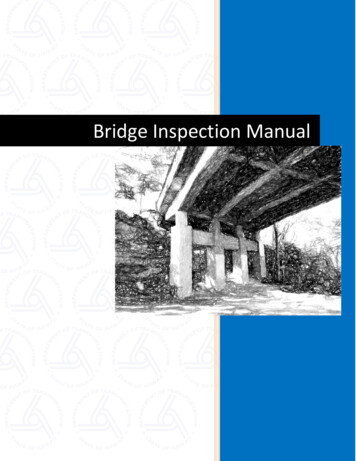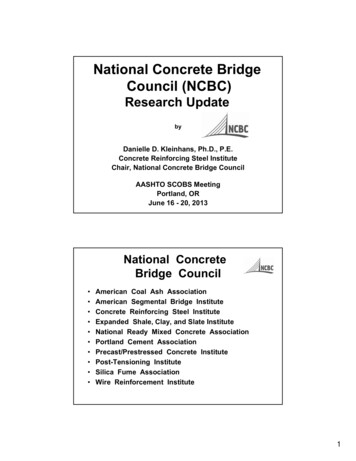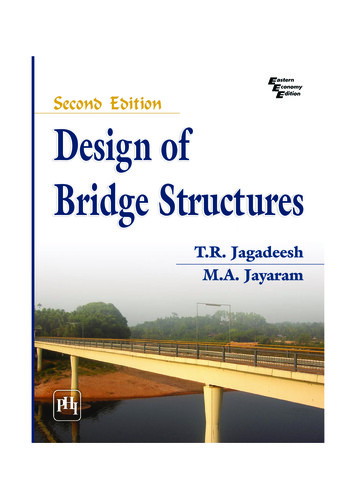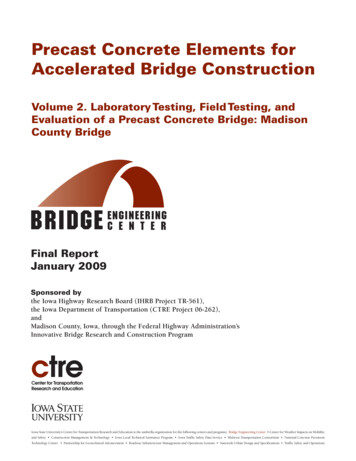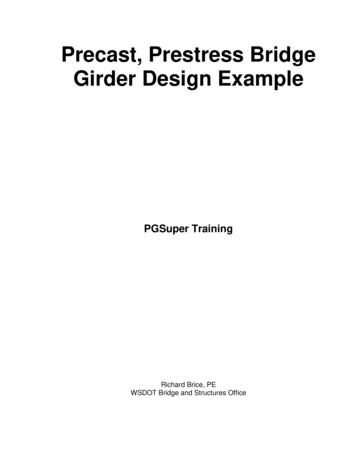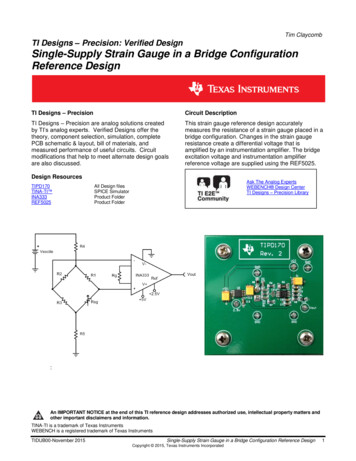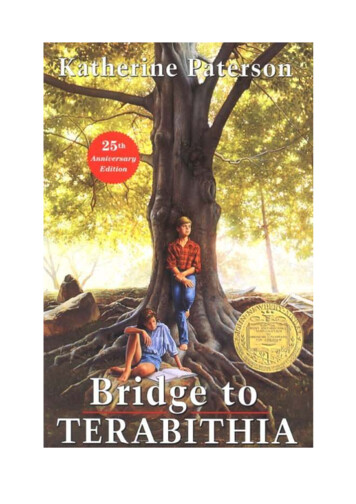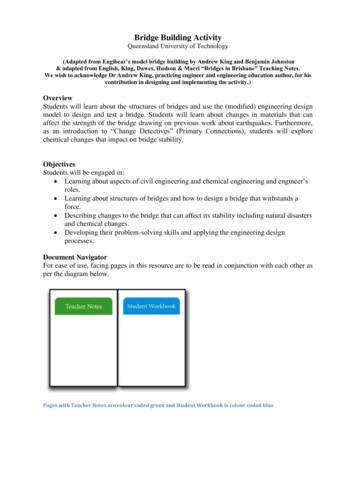
Transcription
Bridge Building ActivityQueensland University of Technology(Adapted from Engibear’s model bridge building by Andrew King and Benjamin Johnston& adapted from English, King, Dawes, Hudson & Macri “Bridges in Brisbane” Teaching Notes.We wish to acknowledge Dr Andrew King, practicing engineer and engineering education author, for hiscontribution in designing and implementing the activity.)OverviewStudents will learn about the structures of bridges and use the (modified) engineering designmodel to design and test a bridge. Students will learn about changes in materials that canaffect the strength of the bridge drawing on previous work about earthquakes. Furthermore,as an introduction to “Change Detectives” (Primary Connections), students will explorechemical changes that impact on bridge stability.ObjectivesStudents will be engaged in: Learning about aspects of civil engineering and chemical engineering and engineer’sroles. Learning about structures of bridges and how to design a bridge that withstands aforce. Describing changes to the bridge that can affect its stability including natural disastersand chemical changes. Developing their problem-solving skills and applying the engineering designprocesses.Document NavigatorFor ease of use, facing pages in this resource are to be read in conjunction with each other asper the diagram below.Pages with Teacher Notes are colour coded green and Student Workbook is colour coded blue
Class Time: 3 hoursThe presentation phase at the end is very important to allow students to clarify their thinkingand share ideas. Please ensure there is plenty of time to get through all presentations.Materials Combined Teaching Notes / Student Workbook.Student Workbook (1 per student).QUT supplied DVD containing:o All images and diagrams in the Combined Teaching Notes should you wish toshow students digitallyo Modified Engineering Design Modelo Digital copies of the A4 pictures laminated of different types of bridgeso ‘Five different types of bridges’ by the Architectural Foundation of ms/design-lab/)N.B: Pages referring to “cable-stayed” in this document have been removed asthey are not applicable to the activityo ‘Lesson Plan for Bridge Building’ by Anjali s/Bridge Building.pdf)o Gumdrop Bridges by hub/Gumdrop-Bridges)Book titled “Engibear’s Bridge”.plain paper (for construction).sticky tape.500g weights for load testing.pencil case including scissors, rulers, pencils, rubbers – student supplied.A4 pictures laminated of different types of bridges – QUT supplied2Bridge Building Activity – Teacher Guide Booklet QUT 2015
Curriculum LinksTechnologyDesign and Technologies Knowledge andUnderstanding Investigate how people in design andtechnology occupations address competingconsiderations, including sustainability inthe design of products, services andenvironments for current and future use(ACTDEK019)ScienceChemical Sciences Earth and Space Sciences Design and Technologies Processes andProduction Skills (ACARA) Changes to materials can be reversible,such as melting, freezing, evaporating;or irreversible, such as burning andrusting (ACSSU095)Sudden geological changes or extremeweather conditions can affect Earth’ssurface (ACSSU096)Generate, develop, communicate anddocument design ideas and processes foraudiences using appropriate technicalterms and graphical representationtechniques (ACTDEP025)Science as a Human Endeavour Scientific understandings, discoveries andinventions are used to solve problems thatdirectly affect peoples’ lives (ACSHE100)Negotiate criteria for success that includeconsideration of sustainability to evaluatedesign ideas, processes and solutions(ACTDEP027) Scientific knowledge is used to informpersonal and community decisions(ACSHE220)MathsMeasurement and GeometryUsing units of measurement Convert between common metricunits of length, mass and capacity(ACMMG136)Geometric Reasoning Investigate, with and without digitaltechnologies, angles on a straightline, angles at a point and verticallyopposite angles. Use results to findunknown angles (ACMMG141)3Bridge Building Activity – Teacher Guide Booklet QUT 2015
PART 1: DIFFERENT TYPES OF BRIDGES - Teacher NotesIntroduction Have resources ready – Five A4 pictures of a beam, truss, suspension, arch andcantilever bridge around the room where students can view them. Read and discuss the book Engibear’s Bridge: Read and discuss the picture book Engibear’s Bridge by Andrew King reminding thestudents that this book was written for younger children. Highlight the importantinformation in the book that will help students to work like engineers today. Explain background information about bridges:Bridges are structures built to get from point A to point B when the land in between isinaccessible. The earliest bridges were simply logs laid across a stream or stonescreating a path across a river, and grew to be more advanced by weaving togethercombinations of sticks, logs, branches, weeds and other fibers to form ropes capableof holding together bridge materials. These simple ideas were the foundations of thebeam designs used in modern culture. Bridges today are made of wood, concrete,and/or steel and have many different structures. Some examples include beam, truss,cantilever, arch, suspension, and cable. These are five of the six types of bridgeshighlighted in Engibear’s book. We have not included cable-stayed in the booklet Hand out Student Workbook and ask students to complete their name, group members,group numbers, class and school on the front. Highlight the five of the six basic bridge types explained in the book: Beam, Truss,Suspension, Arch, Cantilever.Teacher InformationA good resource for teacher background idge/basics.html#beam4Bridge Building Activity – Teacher Guide Booklet QUT 2015
Bridge BuildingStudent workbookYear 6Name:Other group members:Group Number:Class:5Bridge Building Activity – Teacher Guide Booklet QUT 2015
Beam BridgesActivity 1: Similarities and Differences of Bridges (Student workbook page 3)TaskAsk students to: Walk around the room and look at all the different types of bridges that aredisplayed in A4 pictures with names underneath. Think about the similarities and differences of each bridge and record answersin workbook.Go through their answers and reinforce the similarities and differences. In particular,reinforce the five different types of bridges that were read in the Engibear book.Teacher InformationHere are some ideas of similarities and differences:Arch bridges – These bridges used an arch as a main structural component (arch isalways located below the bridge, never above it). They are made with one or more hinges,depending of what kind of load and stress forces they must endure. Examples of archbridge are “Old Bridge” in Mostar, Bosnia and Herzegovina and The Hell Gate Bridge inNew York.Beam bridges – Very basic type of bridges that are supported by several beams ofvarious shapes and sizes. They can be inclined or V shaped. Example of beam bridge isLake Pontchartrain Causeway in southern Louisiana.Truss bridges – Very popular bridge designs that use diagonal mesh of posts above thebridge. The two most common designs are the king posts (two diagonal posts supportedby single vertical post in the center) and queen posts (two diagonal posts, two verticalposts and horizontal post that connect two vertical posts at the top).Cantilever bridges – Similar in appearance to arch bridges, but they support their loadnot through vertical bracing but through diagonal bracing. They often use truss formationboth below and above the bridge. Example of cantilever bridge is Queensboro Bridge inNew York City.Suspension bridges – These are bridges that use ropes or cables from the verticalsuspender to hold the weight of bridge deck and traffic. An example of a suspensionbridge is the Golden Gate Bridge in San Francisco.Source: s/types-of-bridges/6Bridge Building Activity – Teacher Guide Booklet QUT 2015
1. Beam BridgesActivity 1: Similarities and Differences of Bridgesa) Describe how the bridges you have seen in the pictures around the room are similar.b) Describe how the bridges are different.Additional Notes drawings, diagrams, observations, notes, reflections 7Bridge Building Activity – Teacher Guide Booklet QUT 2015
Activity 2: Beam Bridges (Student workbook page 5)Here is a basic picture of a beam bridge.Students have to answer a question about this image in their Workbooks.TaskAsk students: “What do you think makes a beam bridge strong?” “Can you make a beam bridge with your pencil and pencil cases?” Allow studentsone minute to do this. “What would make the pen bend or break – why?” Remind students that there are forces acting on the bridge to keep it stable (seediagram below). Ask students to describe the forces and draw them on the diagramin their workbook.Teacher InformationYou may like to highlight some of the background information below to the students:Beam Bridges are the earliest form of bridges. Cave men and women would have usedthem to cross rivers and gullies by simply pushing a log into position and walking over thelog. The log they walked on is the “beam” and the rocks or land surrounding it supportedit and the cave people on top!These days beam bridges still have a beam – rigid, strong and usually horizontal and thebeam is supported by piers – a vertical column/s at either end. A beam bridge’s strengthdepends on the strength of the beam and the piers. If the length of the beam – the span – istoo long to hold its own weight it would bow in the middle.Here is a simple diagram of the forces that act on a beam bridge. Students will be asked tolabel the compression and tension forces on a blank diagram in their Workbooks.Diagram from:https://www.teachengineering.org/view lesson.php?url collection/cub /lessons/cub brid/cub brid lesson02.xmlTension: What happens to a rope duringa game of tug-of-war? Correct, itundergoes tension from the two sweatyopposing teams pulling on it. This forcealso acts on bridge structures, resultingin tensional stress.Compression: What happens when youpush down on a spring and collapse it?That's right, you compress it, and bysquishing it, you shorten its length.Compressional stress, therefore, is theopposite of tensional ineering/civil/bridge2.htm8Bridge Building Activity – Teacher Guide Booklet QUT 2015
Activity 2: Beam BridgesHere is a picture of a simple beam bridgeMake a beam bridge with your pencil, rubbers and rulers.a) What supports the beam bridge across the bridge?b) What would make the beam of the bridge break?c) You have learnt about forces in Year 4. There are forces acting on the bridge to keep itstable. Label the compression forces and tension forces in the diagram below:9Bridge Building Activity – Teacher Guide Booklet QUT 2015
Activity 3: Trusses that support a beam bridge (Student workbook page 7)Here is a Truss Bridge:Students have to answer a question about this image in their Workbooks.TaskAsk students to: Describe how a Truss bridge is different to a Beam Bridge. Ask students to thinkabout the shapes in the structure. Record answers in the workbook. Complete Activity Three on the Truss Bridge Structure in the workbook.Teacher InformationWhat is the difference between Truss and Beam Bridges?Additional piers can be added or the beam can be strengthened by supporting the beam withtrusses. Trusses are triangular units which are used to hold the bridge together like thispicture:Beam bridges are usually made of concrete and steel with a maximum span between piersof 80 metres. Trusses have a high strength to weight ratio, can span longer distances thanbeam bridges and are used in many structures including bridges, roofs, and rockets. Trussbridges can span up to 180 metres.10Bridge Building Activity – Teacher Guide Booklet QUT 2015
Activity 3: Truss BridgeHere is a picture of a Truss Bridge, which has a beam bridge foundation but an extra part onthe top.a) What do you notice has been added to the beam bridge to support the bridge?b) What shape/s are the structures that have been added?Additional Notes drawings, diagrams, observations, notes, reflections 11Bridge Building Activity – Teacher Guide Booklet QUT 2015
Activity 4: A Cantilever Bridge (another type of Beam Bridge) (Studentworkbook page 9)Below is a photo of the Bolte Bridge in Melbourne – a cantilever bridge.Students have to answer a question about this image in their Workbooks.TaskAsk students: “Has anyone seen bridges like these?” “What do they have in common with the beam bridge and truss bridge?” “What is different about them?” Record answers in workbook. Complete Activity Four in the workbook.Teacher InformationCantilever bridges – Similar in appearance to arch bridges, but they support their loadnot through vertical bracing but through diagonal bracing. They often use trussformation both below and above the bridge.Source: s/types-of-bridges/This diagram shows a cantilever bridge supporting a load:Source: .htm12Bridge Building Activity – Teacher Guide Booklet QUT 2015
Activity 4: Cantilever BridgeHere is a picture of a Cantilever Bridge:a) What do you notice is different about this bridge when compared to a beam bridge ortruss bridge?b) What do you notice is similar about all three types of bridges (truss, beam, andcantilever)?Additional Notes drawings, diagrams, observations, notes, reflections 13Bridge Building Activity – Teacher Guide Booklet QUT 2015
2. Arch Bridges (Student workbook page 11)Task Show students A4 picture of arch bridge (‘basic picture of an arch bridge’seen below).Ask students: “What is different about this bridge compared to the beam bridges we lookedat before?” “What is similar?” “Has anyone seen a bridge like this before?” To complete “Arch Bridges” activity in the workbook.Teacher InformationArch Bridges have been built since the Roman times and were originally made of stone,allowing people to travel over the top of the arch. Later arch bridges were made of metal.These days they are mainly made of concrete as it can be readily moulded into a variety ofshapes. Arch bridges often incorporate a beam or roadway upon which the traffic travels.Modern arch bridges can span 450 metres and due to the nature of their design they leavethe water below free from obstruction by supporting piers. An arch bridge gains itsstrength from the shape of the arch and the strength and stability of the abutments (thestructures at the bottom of the arch that stop the ends of the arch from spreading out) andthe ground in which they are positioned.Here is a basic picture of an arch bridge.Students have to answer a question about this image in their Workbooks.Here is a simple diagram of the forces acting on an arch bridge. The red arrow shows thelocation of the force and the direction of the force. Students have to answer a question aboutthis image in their Workbooks.14Bridge Building Activity – Teacher Guide Booklet QUT 2015
Extra Teacher InformationThe diagram below provides additional information about the forces on an Arch bridgeand terminology:Above picture for teachers only.Diagram from:https://engineeringrome.wikispaces.com/A look into the longevity of Roman EngineeringThis is a photo of the Sydney Harbour Bridge – an arch bridge incorporating a beam.Students have to answer a question about this image in their Workbooks.15Bridge Building Activity – Teacher Guide Booklet QUT 2015
16Bridge Building Activity – Teacher Guide Booklet QUT 2015
2. Arch BridgesHere is a picture of an arch bridge:a) Why is it called an “Arch Bridge?”b) Draw the forces that are acting on an arch bridge in this diagram:c) The picture below is of the Sydney harbour bridge.What types of bridge structures can you see in this picture?17Bridge Building Activity – Teacher Guide Booklet QUT 2015
3. Suspension Bridges (Student workbook page 13)Task Show students A4 picture of suspension bridge.Ask students: “ Why do you think it is called a suspension bridge?” “What is suspending the bridge?” “How could you make a model of a suspension bridge?” “What resources would you need?” To complete the workbook questions on suspension bridges.Teacher InformationSuspension bridges are very strong and can span distances of up to 2000 metres makingthem ideal bridges to span harbours. The main structural elements of a suspension bridgeare the two towers – usually made of concrete or steel, steel wire cables, the roadbed, andthe steel cables holding the roadbed in place. The cables loop over the top of the twotowers and are anchored at each end.Here is a basic picture of a suspension bridge.Students have to answer a question about this image in their Workbooks.Here are the forces on a suspension bridge:Students have to answer a question about this image in their Workbooks.Teacher InformationHere is some more detailed information about the forces:18Bridge Building Activity – Teacher Guide Booklet QUT 2015
3. Suspension BridgesHere is a picture of a suspension bridge:a) Why do you think it is called a Suspension bridge?b) There are many forces operating on a suspension bridge to enable it to be stable andstrong. Draw in some of these forces on the diagram below:19Bridge Building Activity – Teacher Guide Booklet QUT 2015
PART 2: ENGINEERING DESIGN PROCESSSummarise with students the five different types of bridges and how engineers use opposingcompressional and tensional forces to create stable and safe bridges. Explain to students thatengineers determine the best type of bridge to suit an environment based on the bridge loads,soil conditions and cost. Engineers must consider many things -- like the distance to bespanned and the types of materials available -- before determining the size, shape, and overalllook of a bridge. The Engineering Design Process is a method used by engineers tounderstand and overcome design problems.Remind students of the Engineering Design Process that they have done in previousengineering units which will be something they have to use in their challenge today. Askstudents to explain the process to check for understanding. A copy of the process can befound on the teacher DVD. This can be referred to during the discussion and left displayedon the whiteboard for students to access during the challenge.NOTE: Engineering model has changed – if they wish, students can now experiment with thematerials before designing.Engineering Design IGNTESTSOLUTIONModel adapted from pbs.org model20Bridge Building Activity – Teacher Guide Booklet QUT 2015
21Bridge Building Activity – Teacher Guide Booklet QUT 2015
PART 3: BUILDING A BRIDGE (Student workbook page 15) Introduction Explain to students that today they are acting like engineers. They will makemodels of bridges and conduct an experiment to test how well their structurestands up to load capacity testing i.e. the maximum weight the bridge can support.Explain to them that this is similar to what some civil (structural) engineers do astheirs jobs.Ask students to read through the scenario carefully. PROBLEMScenario: You have been asked by the DEEP Engineering Company (DEEPEC) to submit adesign and model to the Brisbane City Council for another footbridge across the BrisbaneRiver. The bridge will need to be wide enough to span the river and high enough for boats topass under it. Council have asked for 1 in 100 scale models of the bridge (i.e., 1 cm in yourmodel represents 1m in real life) and have provided the specifications for the required modelsin Table 1.Table 1 Brisbane City Council Footbridge Model SpecificationsMinimum Span(pier to pier)21 cm(A4 sheetwidth)Minimum Clearance(at bridge centre)Minimum DeckWidthMinimum Load Capacity15 cm(A4 sheet length / 2)15 cm(A4 sheet length /2)500 g( 1 Engibear book)A diagram of A4 paper dimensions is below for reference.Strength and safety are the most important aspects of bridge design. The bridge should becapable of supporting the specified minimum load capacity. Environmental impacts andconstruction costs are also of concern; bridge designs that provide the required span and loadcapacity with minimal material use in construction will be looked upon favourably.Remember to follow the Engineering Design Model.Council are happy to look at a range of bridge designs and will consider bridges of alltypes; including beam bridges, arch bridges, suspension bridges.A4 paper dimensions22Bridge Building Activity – Teacher Guide Booklet QUT 2015
PART 3: BUILDING A BRIDGE1. PROBLEMScenario: You have been asked by the DEEP Engineering Company (DEEPEC) to submit adesign and model to the Brisbane City Council for another footbridge across the BrisbaneRiver. The bridge will need to be wide enough to span the river and high enough for boats topass under it. Council have asked for 1 in 100 scale models of the bridge (i.e., 1 cm in yourmodel represents 1m in real life) and have provided the specifications for the required modelsin Table 1.Table 1 Brisbane City Council Footbridge Model SpecificationsMinimum Span(pier to pier)21 cm(A4 sheetwidth)Minimum Clearance(at bridge centre)Minimum DeckWidthMinimum Load Capacity15 cm(A4 sheet length / 2)15 cm(A4 sheet length /2)500 g( 1 Engibear book)A diagram of A4 paper dimensions is below for reference.Strength and safety are the most important aspects of bridge design. The bridge should becapable of supporting the specified minimum load capacity. Environmental impacts andconstruction costs are also of concern; bridge designs that provide the required span and loadcapacity with minimal material use in construction will be looked upon favourably.Remember to follow the Engineering Design Model.Council are happy to look at a range of bridge designs and will consider bridges of alltypes; including beam bridges, arch bridges, suspension bridges.A4 paper dimensions23Bridge Building Activity – Teacher Guide Booklet QUT 2015
(Student workbook page 17)Council have advertised for bridge design submissions which must include: MATERIALS AND EQUIPMENT You will be given 30 sheets of paper plus an additional 10 sheets of paper forpreliminary testing.1 small roll of sticky tape per group.500g weights CHALLENGEUsing the materials listed you will design a bridge with the specifications above. You willinclude:1. A design drawing of the bridge including your group name.2. A 1 in 100 scale model of the bridge (1 cm represents 1m).3. A list of the amount of material (paper and sticky tape) actually used in constructionof the model bridge. These should be listed on the drawing. An approximatemeasurement (in centimetres) of the amount of sticky tape used is required.4. Certified load testing performance of the model. Tests will be witnessed bysupervising engineers and teachers and results recorded on the drawings.5. You will work in groups of 3.6. You will apply the modified engineering design model as you work.7. You will be given 30 sheets of paper and 1 small roll of sticky tape per group.8. Additional paper (10 sheets) will provided to do some preliminary testing of designsprior to starting work on their full scale bridge.The group whose final design withstands certified load testing and provides therequired span is the winner of the Challenge. If more than one group achieves this, thebridge with the least materials used in construction will win.EXAMPLE BRIDGES ARE PROVIDED OVER PAGE FOR TEACHERREFERENCE ONLY.24Bridge Building Activity – Teacher Guide Booklet QUT 2015
Council have advertised for bridge design submissions which must include:2. MATERIALS AND EQUIPMENT You will be given 30 sheets of paper plus an additional 10 sheets of paper forpreliminary testing.1 small roll of sticky tape per group.3. CHALLENGEUsing the materials listed you will design a bridge with the specifications above. You willinclude:1. A design drawing of the bridge including your group name.2. A 1 in 100 scale model of the bridge (1 cm represents 1m).3. A list of the amount of material (paper and sticky tape) actually used in constructionof the model bridge. These should be listed on the drawing. An approximatemeasurement (in centimetres) of the amount of sticky tape used is required.4. Certified load testing performance of the model. Tests will be witnessed bysupervising engineers and teachers and results recorded on the drawings.5. You will work in groups of 3.6. You will apply the modified engineering design model as you work.7. You will be given 30 sheets of paper and 1 small roll of sticky tape per group.8. Additional paper (10 sheets) will provided to do some preliminary testing of designsprior to starting work on their full scale bridge.The group whose final design withstands certified load testing and provides therequired span is the winner of the Challenge. If more than one group achieves this, thebridge with the least materials used in construction will win.25Bridge Building Activity – Teacher Guide Booklet QUT 2015
Kurilpa Bridge in Brisbane’s CBD26Bridge Building Activity – Teacher Guide Booklet QUT 2015
Teacher Information(FOR TEACHERS ONLY)Here is an example by Andrew King:As a guide, the example bridge shown in Figure 1 Example paper bridgemeets the minimum specifications in Table 1 and was constructed from 14 sheets of A4 paperand much less than 1 small roll of sticky tape. It weighs 75 g and could support a load of about1.5 kg (3 Engibear books) as shown in Figure 2-3. 500g weights will be provided for yourtesting.Figure 1 Example paper bridgeSTAGE 1Example continued overleaf.27Bridge Building Activity – Teacher Guide Booklet QUT 2015
STAGE 2Figure 3 Holding 3 books ( 1.5 kg)STAGE 3Figure 2 Bridge failure at 4 books ( 2 kg)28Bridge Building Activity – Teacher Guide Booklet QUT 2015
4. BRAINSTORM (Student workbook page 19)Explain that squares and triangles are like building blocks that may be arranged and fixedtogether to make bridges.Have students discuss and record answers to the following questions in their StudentWorkbook. What type of bridge do you want to build?What shapes will you use for your bridge?How tall will the bridge be?How wide will the bridge be?How will you make it strong?Draw and label some draft designs in the ‘Thinking Space’ provided on page 11 ofStudent Workbook.5. EXPERIMENT (Student workbook page 19)Remind students of the dimensions of an A4 sheet of paper. There is a diagram of thedimensions on page 8 in their Workbook if they require.Distribute kits of 40 sheets of A4 paper (30 for final construction and 10 for experimentation)and 1 small role of sticky tape to each group. This is just a starter pack. Students may chooseto use more or less of each of the materials however, as previous stated, bridges with minimalmaterial use in construction would be looked upon favourably. Students are allowed tomodify the paper as desired i.e. cut, tear etc.Ask students to work with the materials and experiment with different construction anddesign methods. Students do not have to build their final structure at this stage but should beencouraged to discuss options/cost and start trialing possible designs. The discussion hereshould be rich as students negotiate with each other. Finally, they should agree on the designthey will build from the options they have discussed.29Bridge Building Activity – Teacher Guide Booklet QUT 2015
4. BRAINSTORMDiscuss the questions below with your group. Record your answers in the box. What type of bridge do you want to build? Why? What shapes will you use for your bridge? How tall will the bridge be? How wide will the bridge be? How will you make it strong? Draw and label some draft designs in the ‘Thinking Space’ on page 18.5. EXPERIMENT Your group will be given 30 sheets of paper and 1 small role of stickytape. Additional paper (10 sheets) will be provided to do some preliminarytesting of designs prior to starting work on a full scale bridge. If you wish, you can work with the materials and experiment with different constructionmethods. You are allowed to modify your paper as desired i.e. cut, tear etc. Discuss possible designs with your group, taking into account the quantity of materialsyou use.30Bridge Building Activity – Teacher Guide Booklet QUT 2015
6. DESIGN (Student workbook page 21)After students have experimented and come up with a suitable design, ask them to draw thedesign in their workbooks. Emphasise the need for students to draw and label the shapes withappropriate geometrical terms and to put measurements on the designs. They also need to bemindful of the amount of materials they use.31Bridge Building Activity – Teacher Guide Booklet QUT 2015
6. DESIGN Draw and label your first design.Make sure you label the shapes you used with the correct names.Remember to put measurements on the design.Note the amount of materials you use.32Bridge Building Activity – Teacher Guide Booklet QUT 2015
7. BUILD (Student workbook page 23)Allow groups time to build their bridges. They may have started this during the ‘experimentstage’ but encourage students to refine it here and make sure that it is exactly how they wouldlike it before testing.Groups also need to calculate the total amount of materials used in their bridge using thetable below.MaterialsNumber usedA4 paper(Number of sheets used)Sticky tape(Approximate number of cm used)cm33Bridge Building Activity – Teacher Guide Booklet QUT 2015
7. BUILDBuild your structure using th
These days beam bridges still have a beam - rigid, strong and usually horizontal and the beam is supported by piers - a vertical column/s at either end. A beam bridge's strength depends on the strength of the beam and the piers. If the length of the beam - the span - is too long to hold its own weight it would bow in the middle.
